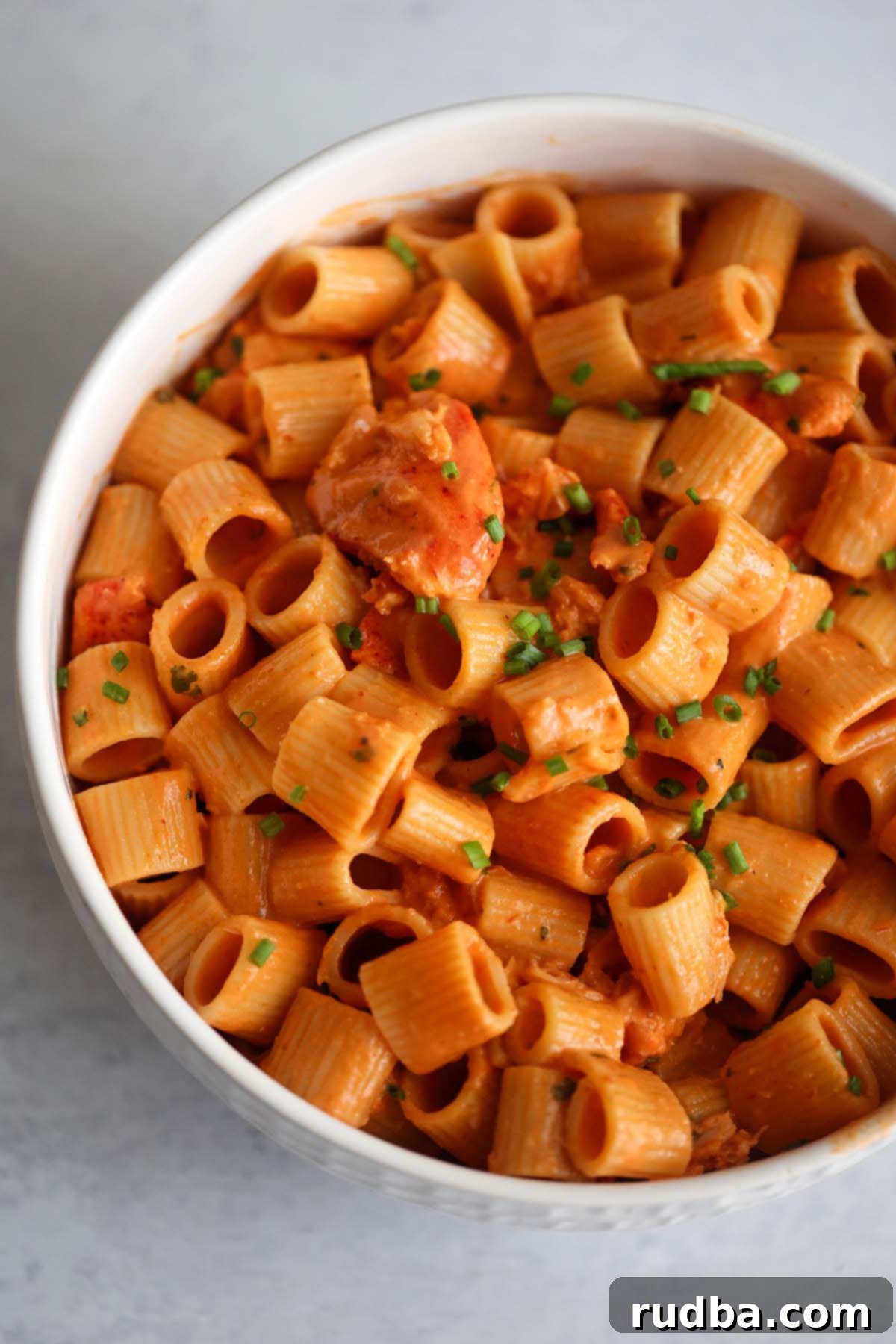Creamy Lobster Pasta: An Easy & Luxurious 30-Minute Recipe
Indulge in a restaurant-quality meal right in your own kitchen with this exquisite Creamy Lobster Pasta recipe. Featuring succulent lobster chunks enveloped in a rich and flavorful tomato cream sauce, this dish is surprisingly simple to make, requiring minimal ingredients and effort. Yet, it promises an unparalleled dining experience that will transport your taste buds to a five-star establishment. It’s the perfect blend of elegance and ease, ideal for a special occasion or when you simply crave something extraordinary.
Pair this luxurious pasta dish with a crisp, simple green salad and some cheesy garlic bread to complete your gourmet meal. The vibrant flavors and creamy texture of the pasta are beautifully complemented by these classic sides, creating a perfectly balanced and utterly satisfying feast.
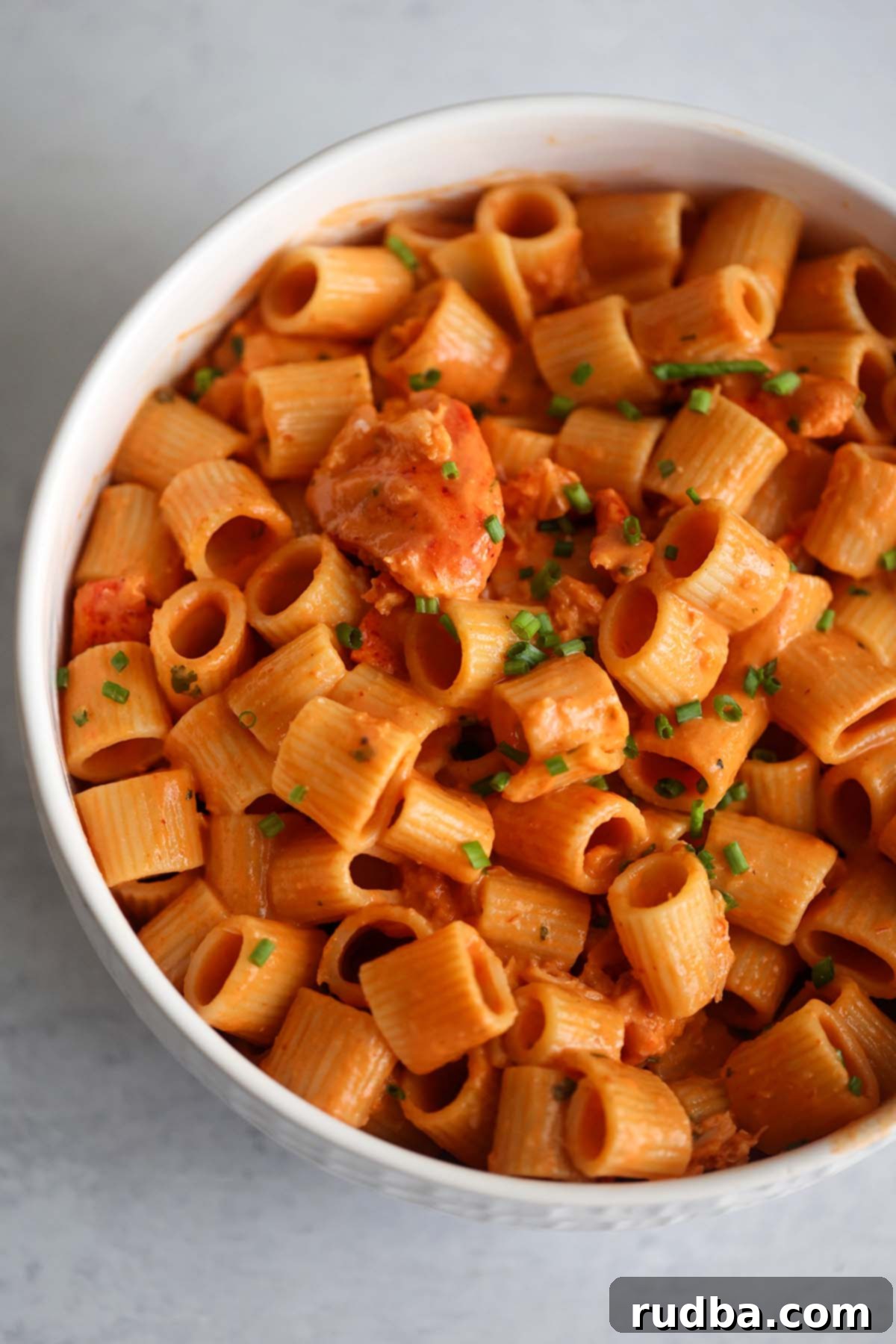
Table of Contents
- Why You’ll Love This Creamy Lobster Pasta
- Essential Ingredients for Lobster Pasta
- Expert Tips for Perfect Creamy Lobster Pasta
- Serving Suggestions for Your Lobster Pasta
- Variations and Substitutions
- How to Store and Reheat Lobster Pasta
- Creamy Lobster Pasta Recipe Card
- Frequently Asked Questions (FAQ)
I recently found myself with a generous amount of leftover lobster meat after whipping up some delicious classic lobster rolls. Rather than letting any of that precious seafood go to waste, my immediate thought was to transform it into a spectacular pasta dish. And I’m so glad I did! This creamy lobster pasta turned out to be an absolute triumph, easily becoming a new favorite in my recipe collection. It’s a fantastic way to utilize leftover lobster or to simply create a truly memorable meal from scratch.
Why You’ll Love This Creamy Lobster Pasta
There are countless reasons to make this incredible creamy lobster pasta, but here are just a few that make it stand out:
- Lightning Fast Preparation: Despite its luxurious appearance, this dish comes together in under 30 minutes. It’s perfect for a weeknight treat or a quick impressive meal when you’re short on time.
- Restaurant-Quality at Home: Forget expensive dining out! This recipe delivers the rich, complex flavors and elegant presentation you’d expect from a high-end restaurant, all from the comfort of your kitchen. Impress your guests or simply treat yourself to a gourmet experience.
- Incredibly Versatile: While lobster is the star here, the creamy tomato sauce is incredibly adaptable. Don’t have lobster? No problem! You can easily substitute it with other proteins like tender chicken, succulent shrimp, flaky crab meat, or even scallops. This flexibility means you can enjoy this delicious sauce with your favorite seafood or poultry.
- Unforgettable Flavor Profile: Did I mention how absolutely delicious it is? The combination of sweet lobster, savory tomato, rich cream, and aromatic herbs creates a symphony of flavors that is truly addictive. It’s a dish you’ll crave again and again.
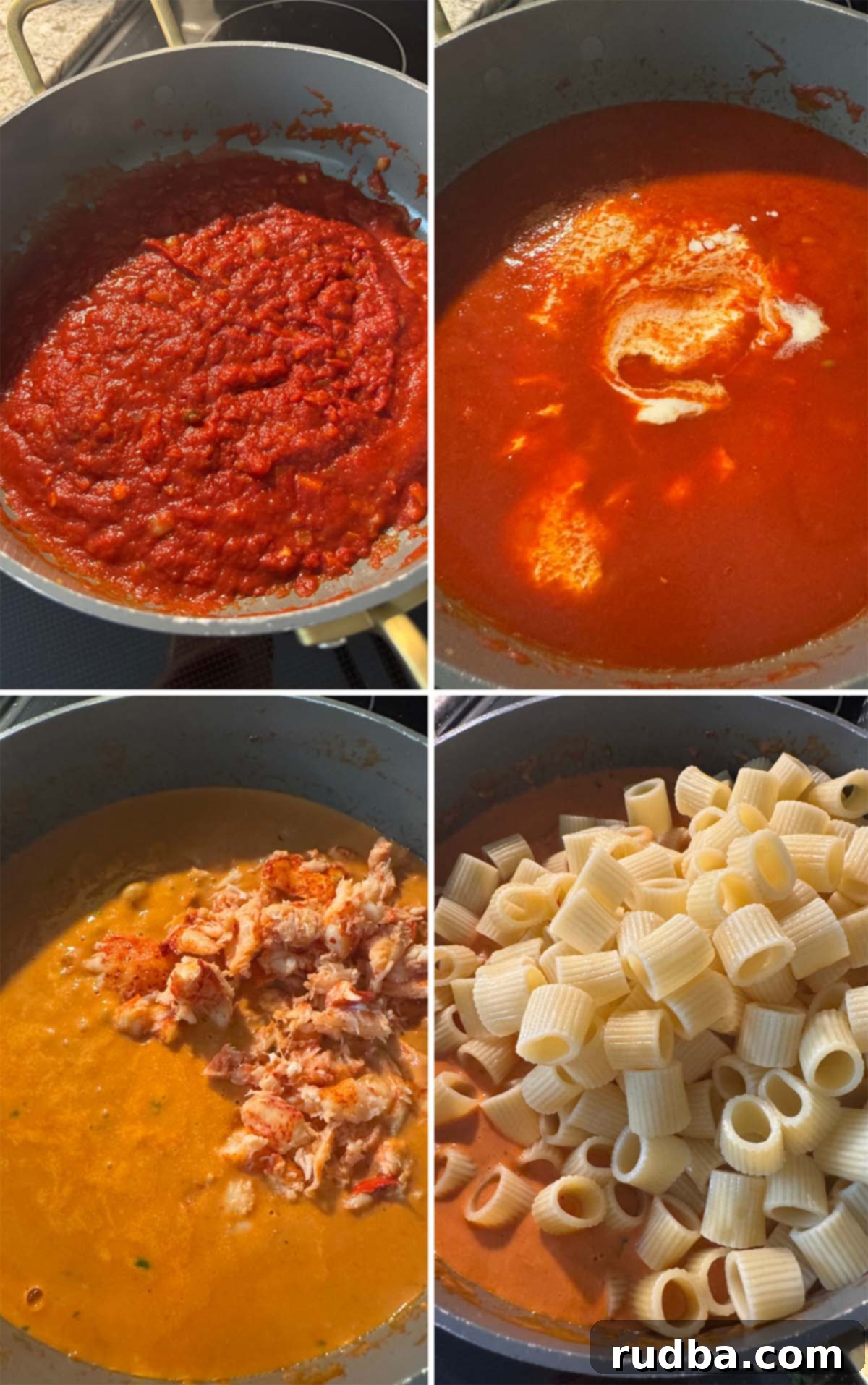
Essential Ingredients for Lobster Pasta
Crafting the perfect creamy lobster pasta begins with selecting the right ingredients. Each component plays a vital role in building the dish’s rich and balanced flavor. Below, we’ll dive deeper into each item, offering insights and tips for the best results.
Refer to the full recipe card below for exact quantities and comprehensive step-by-step instructions.
- Lobster: I utilized pre-cooked lobster meat, which significantly speeds up preparation. However, if you prefer using raw lobster meat, the results will be even more tender and flavorful. Simply sauté the raw lobster in a little olive oil for a few minutes until it’s no longer translucent and cooked through. Be careful not to overcook it, as lobster can become rubbery. If using frozen lobster, ensure it’s completely thawed and any excess moisture is drained or patted dry before adding it to the sauce. I often use a mix of lobster tail, claws, and knuckle meat for varied textures, but any type of lobster you have on hand will work beautifully.
- Pasta: My personal choice for this recipe is mezzi rigatoni, as its ridged surface and tubular shape are excellent for capturing the rich cream sauce. However, feel free to use your favorite pasta shape. Spaghetti, fettuccine, linguine, penne, or even a shorter pasta like orecchiette or farfalle would be delicious. The key is to cook your pasta to a perfect al dente texture according to package instructions, as it will continue to cook slightly when tossed with the hot sauce.
- Tomato Paste: This concentrated ingredient is crucial for building a deep, savory, and slightly sweet foundation for our tomato cream sauce. Cooking the tomato paste for a minute or two before adding liquids helps to deepen its flavor, transforming it from bright and acidic to rich and complex.
- Onion and Garlic: Finely diced onion and minced garlic form the aromatic backbone of the sauce. They add depth, sweetness, and a pungent savory note that perfectly complements the seafood. Don’t rush the cooking of the onions; allow them to become translucent and slightly sweet for the best flavor.
- Calabrian Chilies (Optional): For those who enjoy a subtle kick, Calabrian chilies add a wonderful spicy warmth and a touch of fruity flavor. If you don’t have them, a pinch of red pepper flakes is an excellent substitute to achieve a similar gentle heat. Adjust the amount according to your preference for spice.
- Dry White Wine (Optional): A dry white wine, such as Pinot Grigio or Sauvignon Blanc, adds a sophisticated layer of flavor and helps to deglaze the pan, picking up all those delicious browned bits from the bottom. It also adds a touch of acidity that brightens the sauce. Make sure to choose a dry, not fruity, wine. If you prefer to omit alcohol, chicken or seafood stock are fantastic non-alcoholic alternatives that will still contribute depth of flavor.
- Pasta Water: The starchy water left over from cooking your pasta is liquid gold for sauces! It helps to emulsify the sauce, creating a silky, cohesive texture that clings beautifully to the pasta. Don’t skip this step – reserve at least a cup before draining your pasta.
- Heavy Cream: This is where the “creamy” in creamy lobster pasta truly comes from. Heavy cream adds luxurious richness and body to the tomato sauce, making it incredibly smooth and decadent. For a slightly lighter option, you could use half-and-half, but the heavy cream provides the most indulgent texture.
- Parmesan Cheese: Freshly grated Parmesan cheese melts seamlessly into the sauce, adding a salty, umami-rich flavor that enhances the overall profile. Always opt for freshly grated Parmesan over pre-shredded, as it melts better and offers superior flavor.
- Lemon: A squeeze of fresh lemon juice at the end is a game-changer. It brightens the sauce, cuts through the richness of the cream, and highlights the natural sweetness of the lobster. Don’t underestimate its impact!
- Fresh Herbs (Parsley and Basil): Freshly chopped parsley and basil add vibrant color and a burst of fresh, aromatic flavor that elevates the dish. Stir them in at the very end to preserve their bright taste and aroma.
- Chives (for garnishing, optional): A sprinkle of fresh chives adds a delicate oniony note and a beautiful green garnish.
- Sugar: A small pinch of sugar helps to balance the acidity of the tomato paste, ensuring a perfectly harmonious sauce. Taste and adjust as needed.
- Salt and Pepper: Season generously throughout the cooking process. Tasting and adjusting the seasoning is key to a perfectly balanced dish.
- Olive Oil: Essential for sautéing the aromatics and building the initial flavor base of the sauce. Use a good quality extra virgin olive oil for the best taste.
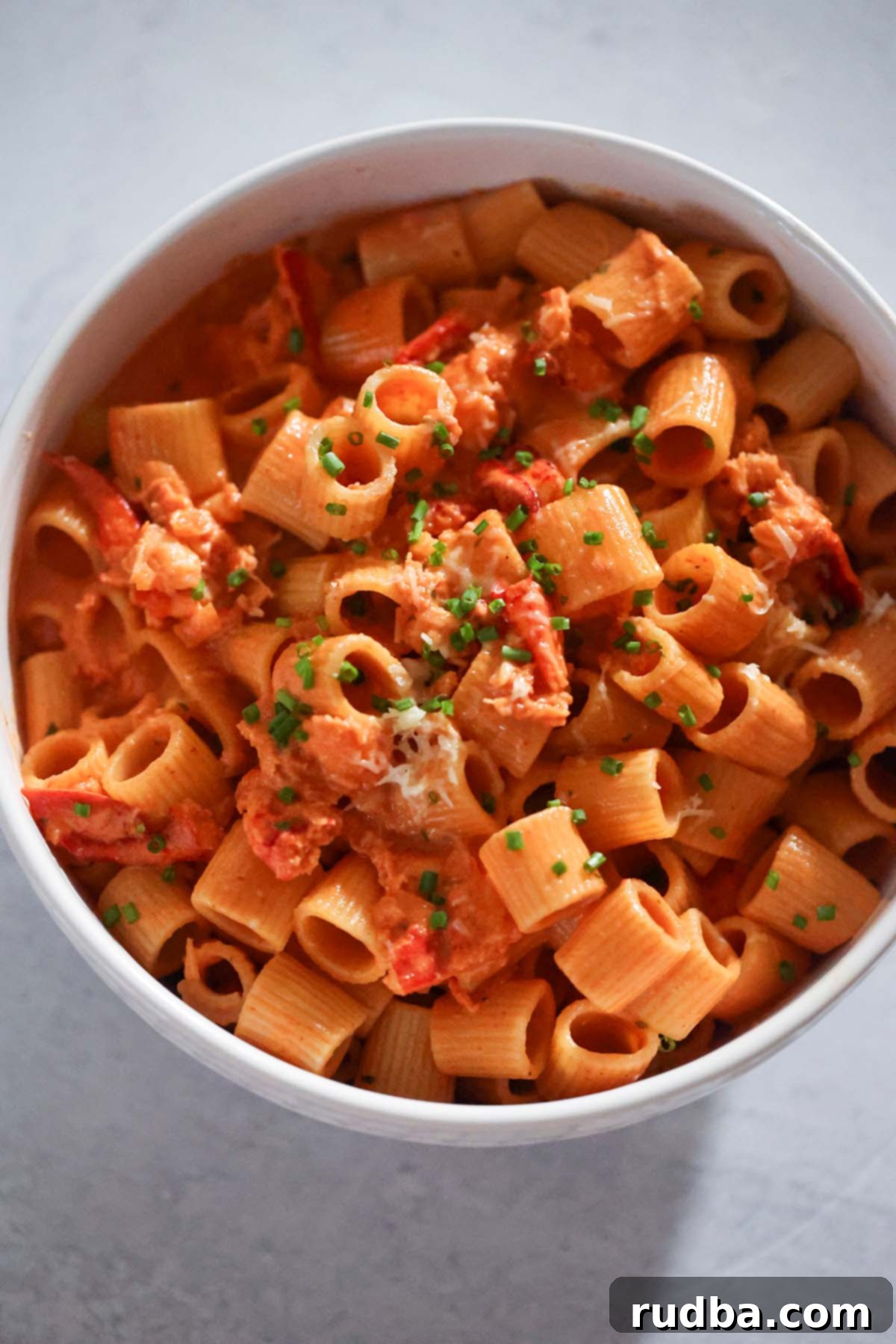
Expert Tips for Perfect Creamy Lobster Pasta
- Al Dente Pasta is Key: Always cook your pasta to al dente, meaning it’s still firm to the bite. It will continue to cook slightly when added to the hot sauce, preventing it from becoming mushy.
- Don’t Overcook the Lobster: Lobster cooks very quickly, especially if using pre-cooked meat. Add it at the very end and only simmer for a few seconds until it’s just warmed through to maintain its tender texture. Overcooked lobster becomes tough and rubbery.
- Season in Layers: Don’t wait until the very end to season. Season the onions and garlic, then the tomato paste, and finally the sauce as it simmers. This builds layers of flavor. Always taste and adjust salt and pepper before serving.
- Balance the Acidity: Tomato paste can be quite acidic. A small amount of sugar helps to balance this acidity and bring out the natural sweetness of the tomatoes, resulting in a more harmonious sauce.
- Reserve Pasta Water: This starchy water is your secret weapon! It helps to thin the sauce to the perfect consistency while also helping it emulsify and cling beautifully to the pasta. Never drain all your pasta water without reserving some.
- Fresh is Best for Herbs: While dried herbs can be used in a pinch, fresh parsley and basil offer a vibrant flavor and aroma that significantly elevates this dish. Add them right at the end to preserve their freshness.
- Use Quality Ingredients: With a simple dish like this, the quality of your ingredients really shines through. Opt for good quality olive oil, fresh garlic, and high-quality Parmesan cheese.
- Taste, Taste, Taste: The most important tip for any cook! Continuously taste your sauce as you build it and adjust seasonings (salt, pepper, sugar, lemon juice) until it’s perfectly balanced to your liking.
Serving Suggestions for Your Lobster Pasta
This creamy lobster pasta is a star on its own, but it pairs beautifully with a few simple accompaniments to create a complete and unforgettable meal. A crisp green salad with a light vinaigrette offers a refreshing counterpoint to the rich pasta. Don’t forget a generous portion of warm, cheesy garlic bread to soak up every last drop of that incredible sauce. For drinks, a dry white wine like Pinot Grigio or Chardonnay would complement the seafood perfectly. A sparkling water with lemon is also a great refreshing choice.
Variations and Substitutions
- Protein Swaps: As mentioned, chicken, shrimp, crab, or scallops are excellent alternatives to lobster. For a vegetarian option, consider adding sautéed mushrooms, asparagus, or cherry tomatoes.
- Cheese Alternatives: While Parmesan is classic, Pecorino Romano could add a sharper, saltier kick. A blend of Italian cheeses would also be delicious.
- Spice Level: If you love heat, increase the amount of Calabrian chilies or red pepper flakes. For a milder dish, omit them entirely.
- Herb Profile: Experiment with other fresh herbs like oregano or thyme, or a blend of Italian herbs.
- Lighter Sauce: For a slightly less rich sauce, you can use half-and-half instead of heavy cream, though the texture will be a bit thinner.
- Gluten-Free: Simply use your favorite gluten-free pasta, ensuring it’s cooked al dente.
How to Store and Reheat Lobster Pasta
If you happen to have any precious leftovers (a rare occurrence with this dish!), it’s important to store and reheat them properly to maintain quality.
- Storage: Place any leftover creamy lobster pasta in an airtight container and refrigerate promptly. Due to the seafood and cream, it’s best consumed within 1-2 days. You want to avoid keeping seafood in the fridge for too long to ensure freshness and safety.
- Reheating: To reheat, gently warm the pasta in a skillet over medium-low heat on the stovetop, or in the microwave. If the sauce has thickened too much in the fridge, you may want to add a splash of milk, cream, or even a little water (or reserved pasta water, if you have any left) to loosen it up and restore its creamy texture. Stir frequently until heated through. Be careful not to overheat, especially the lobster, to prevent it from becoming tough.
Creamy Lobster Pasta Recipe Card
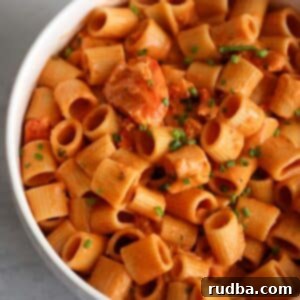
Creamy Lobster Pasta
By: Julie Maestre
This creamy lobster pasta is made with tender lobster chunks and a delectable tomato cream sauce. It’s a quick and easy recipe that delivers a luxurious, five-star dining experience at home.
Cook Time: 20 mins
Total Time: 25 mins
Servings: 4
Ingredients
- 1 lb mezzi rigatoni, cooked according to package instructions
- ½ lb cooked lobster meat, cut into chunks
- 6 ounces tomato paste
- ½ onion, finely diced
- 2 garlic cloves, finely minced
- ½ teaspoon Calabrian chilies, optional (or red pepper flakes)
- ½ cup dry white wine, optional (or chicken/seafood stock)
- 1 cup pasta water (reserved from cooking pasta)
- 1 cup heavy cream
- ½ cup freshly grated Parmesan cheese
- ½ lemon, for juice
- 2 teaspoons fresh parsley, chopped
- 2 teaspoons fresh basil, chopped
- Chives, for garnishing (optional)
- Sugar, to taste
- Salt and pepper, to taste
- Olive oil
Instructions
- Heat a few tablespoons of olive oil in a large skillet or Dutch oven over medium heat.
- Add the finely diced onions and cook for 2-3 minutes, stirring occasionally, until they become translucent and slightly softened. Stir in the minced fresh garlic and Calabrian chilies (if using) and cook for an additional 20 seconds until fragrant, being careful not to burn the garlic.
- Add the tomato paste to the skillet and cook for 1 minute, stirring constantly. This step helps to deepen the flavor of the tomato paste.
- Pour in the white wine (if using) and let it simmer for 1 minute, allowing the alcohol to cook off and deglaze the pan. Then, add the reserved pasta water and the juice from half a lemon. Let the sauce simmer for another minute, allowing the flavors to meld.
- Stir in the heavy cream and a pinch of sugar (to taste, balancing the acidity of the tomatoes). Let it simmer gently for 1 minute until slightly thickened. Then, incorporate the freshly grated Parmesan cheese, chopped basil, and parsley. Season generously with salt and pepper to your liking.
- Gently fold in the cooked lobster meat. Allow it to simmer in the sauce for just a few seconds, or until the lobster is nice and warm. Be extremely careful not to overcook the lobster, as it can become tough.
- Finally, add the cooked mezzi rigatoni (or your chosen pasta) to the sauce. Toss everything together until the pasta is thoroughly coated. Taste and adjust seasoning one last time. Garnish with fresh chives, if desired, and serve immediately. Enjoy your luxurious Creamy Lobster Pasta!
Notes
- If you don’t have Calabrian chilies, red pepper flakes are a perfect substitute to add a touch of heat.
- For a non-alcoholic option, chicken or seafood stock can be used in place of white wine.
Nutrition
Nutrition information is automatically calculated, so should only be used as an approximation.
- Calories: 541 kcal
- Carbohydrates: 48g
- Protein: 24g
- Fat: 26g
- Saturated Fat: 16g
- Polyunsaturated Fat: 2g
- Monounsaturated Fat: 7g
- Trans Fat: 0.01g
- Cholesterol: 148mg
- Sodium: 799mg
- Potassium: 710mg
- Fiber: 4g
- Sugar: 9g
- Vitamin A: 1630 IU
- Vitamin C: 11mg
- Calcium: 269mg
- Iron: 3mg
Frequently Asked Questions (FAQ)
- Can I use raw lobster meat for this recipe?
- Absolutely! Using raw lobster meat can yield even more tender and flavorful results. Simply sauté the raw lobster chunks in a little olive oil for 2-3 minutes until they are opaque and cooked through before adding them to the sauce. Make sure not to overcook, as lobster can become tough quickly.
- What’s the best type of pasta for creamy sauces?
- Pastas with ridges or tubes, like rigatoni, penne, or cavatappi, are excellent for creamy sauces as they help the sauce cling better. Long pastas like fettuccine or linguine also work wonderfully, providing a classic Italian feel.
- Is the white wine really necessary?
- The white wine adds a layer of depth and acidity that brightens the sauce and helps deglaze the pan. However, if you prefer to avoid alcohol, you can easily substitute it with chicken broth or seafood stock. The dish will still be delicious.
- How do I prevent the lobster from getting rubbery?
- The key is to add the lobster towards the very end of the cooking process, especially if it’s already cooked. Just let it simmer in the warm sauce for a few seconds until it’s heated through. Raw lobster also cooks quickly, so watch it carefully when sautéing.
- Can I make this dish ahead of time?
- While best enjoyed fresh, you can prepare the sauce ahead of time. Cook the pasta and warm the lobster separately, then combine everything just before serving for optimal texture and flavor. Stored assembled pasta with seafood and cream might lose some quality upon reheating.
- What if my sauce is too thick or too thin?
- If your sauce is too thick, gradually add more reserved pasta water until it reaches your desired consistency. If it’s too thin, let it simmer gently for a few more minutes to reduce and thicken, or stir in a small amount of grated Parmesan cheese.
Tried This Recipe?
We’d love to hear from you! If you’ve made this Creamy Lobster Pasta, please consider leaving a review. Your feedback is invaluable and helps us improve our recipes. Thank you for sharing your experience! ❤️
Like this recipe? Leave a comment below!
